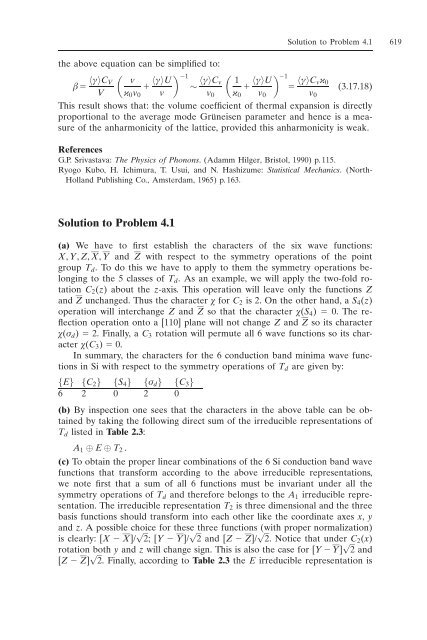10. Appendix
You also want an ePaper? Increase the reach of your titles
YUMPU automatically turns print PDFs into web optimized ePapers that Google loves.
Solution to Problem 4.1 619<br />
the above equation can be simplified to:<br />
‚ 〈Á〉CV<br />
<br />
v<br />
<br />
V Î0v0<br />
〈Á〉U<br />
1 ∼<br />
v<br />
〈Á〉Cv<br />
<br />
1<br />
<br />
v0 Î0<br />
〈Á〉U<br />
1 <br />
v0<br />
〈Á〉CvÎ0<br />
(3.17.18)<br />
v0<br />
This result shows that: the volume coefficient of thermal expansion is directly<br />
proportional to the average mode Grüneisen parameter and hence is a measure<br />
of the anharmonicity of the lattice, provided this anharmonicity is weak.<br />
References<br />
G.P. Srivastava: The Physics of Phonons. (Adamm Hilger, Bristol, 1990) p. 115.<br />
Ryogo Kubo, H. Ichimura, T. Usui, and N. Hashizume: Statistical Mechanics. (North-<br />
Holland Publishing Co., Amsterdam, 1965) p. 163.<br />
Solution to Problem 4.1<br />
(a) We have to first establish the characters of the six wave functions:<br />
X, Y, Z, X, Y and Z with respect to the symmetry operations of the point<br />
group Td. To do this we have to apply to them the symmetry operations belonging<br />
to the 5 classes of Td. As an example, we will apply the two-fold rotation<br />
C2(z) about the z-axis. This operation will leave only the functions Z<br />
and Z unchanged. Thus the character ¯ for C2 is 2. On the other hand, a S4(z)<br />
operation will interchange Z and Z so that the character ¯(S4) 0. The reflection<br />
operation onto a [110] plane will not change Z and Z so its character<br />
¯(Ûd) 2. Finally, a C3 rotation will permute all 6 wave functions so its character<br />
¯(C3) 0.<br />
In summary, the characters for the 6 conduction band minima wave functions<br />
in Si with respect to the symmetry operations of Td are given by:<br />
{E} {C2} {S4} {Ûd} {C3}<br />
6 2 0 2 0<br />
(b) By inspection one sees that the characters in the above table can be obtained<br />
by taking the following direct sum of the irreducible representations of<br />
Td listed in Table 2.3:<br />
A1 ⊕ E ⊕ T2 .<br />
(c) To obtain the proper linear combinations of the 6 Si conduction band wave<br />
functions that transform according to the above irreducible representations,<br />
we note first that a sum of all 6 functions must be invariant under all the<br />
symmetry operations of Td and therefore belongs to the A1 irreducible representation.<br />
The irreducible representation T2 is three dimensional and the three<br />
basis functions should transform into each other like the coordinate axes x, y<br />
and z. A possible choice for these three functions (with proper normalization)<br />
is clearly: [X X]/ √ 2; [Y Y]/ √ 2 and [Z Z]/ √ 2. Notice that under C2(x)<br />
rotation both y and z will change sign. This is also the case for [Y Y] √ 2 and<br />
[Z Z] √ 2. Finally, according to Table 2.3 the E irreducible representation is










